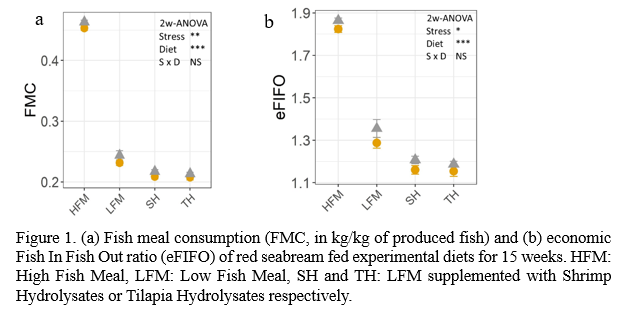AQUACULTURE BY-PRODUCTS: A SOLUTION TO REDUCE THE USE OF FISHMEAL IN A CARNIVOROUS FISH PRODUCTION
Over 35% of global fishery stocks are overexploited (FAO, 2022), partly driven by the demand for small pelagic fish to feed carnivorous farmed species. To address this, the aquaculture sector has significantly reduced fishmeal (FM) in feeds , from 50% in 1997 to 14% in 2017 (Naylor et al., 2021) . Yet, overall FM use continues to rise due to rapid aquaculture growth. While plant proteins like soy have helped lower FM content, they bring nutritional and economic challenges. Alternative proteins and fats are being developed but remain limited by cost and availability, whereas aquaculture by-products are abundant, inexpensive, and, through enzymatic hydrolysis, offer promising nutritional and functional benefits.
We undertook a study to assess the feasibility of halving the FM content (low fish meal -LFM- vs high fish meal -HFM-) in the pre-grower diet of red sea bream (Pagrus major ), with or without supplementing with protein hydrolysates derived from aquaculture by-products (shrimp hydrolysate -SH- or tilapia hydrolysate -TH-). We also included stress situations (daily net chasing for 1 minute) to study the interactions between farming stress and diet. After 15 weeks of rearing and the final weighing, the fish were subjected to physiological sampling and a bacterial challenge to better understand the underlying physiological mechanisms.
Although the diet with low FM content yielded very satisfactory zootechnical performance, close to that of the control diet, the addition of hydrolysates accelerated growth while reducing the feed conversion ratio, and FM use (Fig. 1) . Stress similarly impacted all diets, reducing feed intake, growth, and health indicators. All these results are supported by variations in intestinal structure, cortisol levels, and the expression of growth factors in the liver. Hydrolysates also reduced sensitivity to bacterial infection in fish fed the L FM diet. These effects appeared to be linked to improvements in several markers of the non-specific immune system.
Overall, this study highlights the great potential of hydrolysates to further reduce aquaculture’s dependency towards wild fish and pave the way for future research on feed optimization.
